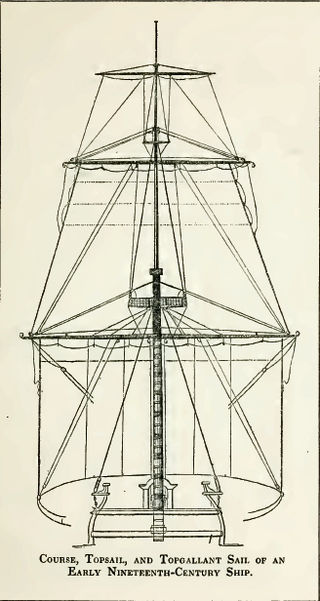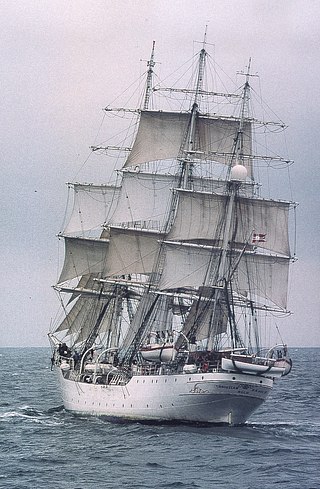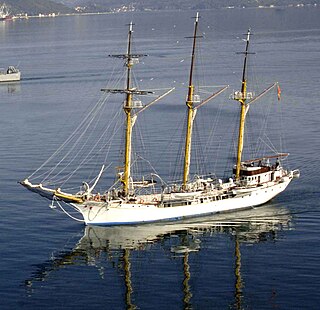
A schooner is a type of sailing vessel defined by its rig: fore-and-aft rigged on all of two or more masts and, in the case of a two-masted schooner, the foremast generally being shorter than the mainmast. A common variant, the topsail schooner also has a square topsail on the foremast, to which may be added a topgallant. Differing definitions leave uncertain whether the addition of a fore course would make such a vessel a brigantine. Many schooners are gaff-rigged, but other examples include Bermuda rig and the staysail schooner.

A sailing vessel's rig is its arrangement of masts, sails and rigging. Examples include a schooner rig, cutter rig, junk rig, etc. A rig may be broadly categorized as "fore-and-aft", "square", or a combination of both. Within the fore-and-aft category there is a variety of triangular and quadrilateral sail shapes. Spars or battens may be used to help shape a given kind of sail. Each rig may be described with a sail plan—formally, a drawing of a vessel, viewed from the side.

A brig is a type of sailing vessel defined by its rig: two masts which are both square-rigged. Brigs originated in the second half of the 18th century and were a common type of smaller merchant vessel or warship from then until the latter part of the 19th century. In commercial use, they were gradually replaced by fore-and-aft rigged vessels such as schooners, as owners sought to reduce crew costs by having rigs that could be handled by fewer men. In Royal Navy use, brigs were retained for training use when the battle fleets consisted almost entirely of iron-hulled steamships.

A tall ship is a large, traditionally-rigged sailing vessel. Popular modern tall ship rigs include topsail schooners, brigantines, brigs and barques. "Tall ship" can also be defined more specifically by an organization, such as for a race or festival.

A topsail ("tops'l") is a sail set above another sail; on square-rigged vessels further sails may be set above topsails.

A barquentine or schooner barque is a sailing vessel with three or more masts; with a square rigged foremast and fore-and-aft rigged main, mizzen and any other masts.

Gaff rig is a sailing rig in which the sail is four-cornered, fore-and-aft rigged, controlled at its peak and, usually, its entire head by a spar (pole) called the gaff. Because of the size and shape of the sail, a gaff rig will have running backstays rather than permanent backstays.

A full-rigged ship or fully rigged ship is a sailing vessel with a sail plan of three or more masts, all of them square-rigged. Such a vessel is said to have a ship rig or be ship-rigged, with each mast stepped in three segments: lower, top, and topgallant.

Earl of Pembroke was a wooden, three-masted barque, which was frequently used for maritime festivals, charters, charity fund raising, corporate entertaining and film work.

KRI Dewaruci is a Class A tall ship and the only barquentine owned and operated by the Indonesian Navy. She is used as a sail training vessel for naval cadets and is the largest tall ship in the Indonesian fleet. Dewaruci also serves as a goodwill ambassador for Indonesia to the rest of the world.

Juan Sebastián de Elcano is a training ship of the Spanish Navy. It is a four-masted topsail, steel-hulled barquentine. At 113 metres (371 ft) long, it is the third-largest tall ship in the world, and is the sailing vessel that has sailed the furthest, covering more than 2,000,000 nautical miles in its lifetime.

ARA Libertad (Q-2) is a steel-hulled, full-rigged, class "A" sailing ship that serves as a school vessel in the Argentine Navy. One of the largest and fastest tall ships in the world, holder of several speed records, she was designed and built in the 1950s by the Río Santiago Shipyard, Ensenada, Argentina. Her maiden voyage was in 1961, and she continues to be a training ship with yearly instruction trips for the graduating naval cadets as well as a traveling goodwill ambassador, having covered more than 800,000 nautical miles (1,500,000 km) across all seas, visited about 500 ports in more than 60 countries, and trained more than 11,000 navy graduates.

Potosi was a five-masted steel barque built in 1865 by Joh. C. Tecklenborg ship yard in Geestemünde, Germany, for the sailing ship company F. Laeisz as a trading vessel. Its primary purpose was as a "nitrate clipper" collecting guano in South America for use in chemical companies in Germany. As its shipping route was between Germany, Bolivia until 1870 but, during the "pacific War" was transferred to Chile, it was designed to be capable of withstanding the rough weather encountered around Cape Horn.

Jadran is a sailing ship for basic naval training built for the Yugoslav Royal Navy and currently in Montenegrin Navy service. A three-mast topsail schooner or barquentine with an auxiliary engine, Jadran was built in Hamburg, Germany between 1930 and 1933, and commissioned on 19 August 1933. Prior to World War II she completed seven long training cruises with trainees from the Yugoslav Naval Academy, including one to North America. As Yugoslavia was neutral at the outbreak of World War II, Jadran was able to conduct short cruises in the Adriatic Sea. In April 1941, Yugoslavia was invaded by the Axis powers, and Jadran was captured and renamed Marco Polo by the Italian Navy. She continued to be used as a training ship in the Adriatic, operating out of the Istrian port of Pola, and was featured in an Italian propaganda film.

The Tall Ships Races are races for sail training "tall ships". The races are designed to encourage international friendship and training for young people in the art of sailing. The races are held annually in European waters and consists of two racing legs of several hundred nautical miles, and a "cruise in company" between the legs. Over one half of the crew of each ship participating in the races must consist of young people.
Alexandria was a cargo-carrying three-masted schooner built in 1929. Originally named Yngve, she was built at Björkenäs, Sweden, and fitted with a 58 H.P. auxiliary oil engine.

J.R. Tolkien is a gaff-topsail schooner of Netherlands registry used for passenger cruises on the Baltic Sea and elsewhere in European waters.

The tall ship Spirit of New Zealand is a steel-hulled, three-masted barquentine from Auckland, New Zealand. It was purpose-built by the Spirit of Adventure Trust in 1986 for youth development. It is 42.5 m in total length and carries a maximum of 40 trainees and 14 crew on overnight voyages. The ship's home port is Auckland, and it spends most of its time sailing around the Hauraki Gulf. During the summer season, it often sails to the Marlborough Sounds and Nelson, at the top of the South Island.

Amazing Grace is an 83' topsail schooner. Its home port is in San Juan, Puerto Rico. The ship serves as the platform for the non-profit Maritime Leadership and is also available for private charters and memorials at sea. Maritime Leadership provides traditional sail training adventures through sailings ranging from 3–48 hours.

A sail plan is a drawing of a sailing craft, viewed from the side, depicting its sails, the spars that carry them and some of the rigging that supports the rig. By extension, "sail plan" describes the arrangement of sails on a craft. A sailing craft may be waterborne, an iceboat, or a sail-powered land vehicle.





















